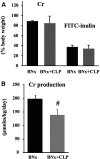Reduced production of creatinine limits its use as marker of kidney injury in sepsis
- PMID: 19389851
- PMCID: PMC2689892
- DOI: 10.1681/ASN.2008060617
Reduced production of creatinine limits its use as marker of kidney injury in sepsis
Abstract
Although diagnosis and staging of acute kidney injury uses serum creatinine, acute changes in creatinine lag behind both renal injury and recovery. The risk for mortality increases when acute kidney injury accompanies sepsis; therefore, we sought to explore the limitations of serum creatinine in this setting. In mice, induction of sepsis by cecal ligation and puncture in bilaterally nephrectomized mice increased markers of nonrenal organ injury and serum TNF-alpha. Serum creatinine, however, was significantly lower in septic animals than in animals subjected to bilateral nephrectomy and sham cecal ligation and puncture. Under these conditions treatment with chloroquine decreased nonrenal organ injury markers but paradoxically increased serum creatinine. Sepsis dramatically decreased production of creatinine in nephrectomized mice, without changes in body weight, hematocrit, or extracellular fluid volume. In conclusion, sepsis reduces production of creatinine, which blunts the increase in serum creatinine after sepsis, potentially limiting the early detection of acute kidney injury. This may partially explain why small absolute increases in serum creatinine levels are associated with poor clinical outcomes. These data support the need for new biomarkers that provide better measures of renal injury, especially in patients with sepsis.
Figures



Similar articles
-
Comparison of serum creatinine and serum cystatin C as biomarkers to detect sepsis-induced acute kidney injury and to predict mortality in CD-1 mice.Am J Physiol Renal Physiol. 2014 Oct 15;307(8):F939-48. doi: 10.1152/ajprenal.00025.2013. Epub 2014 Aug 20. Am J Physiol Renal Physiol. 2014. PMID: 25143457 Free PMC article.
-
Serum Neutrophil Gelatinase Associated Lipocalin (NGAL) Outperforms Serum Creatinine in Detecting Sepsis-Induced Acute Kidney Injury, Experiments on Bilateral Nephrectomy and Bilateral Ureter Obstruction Mouse Models.Shock. 2016 May;45(5):570-6. doi: 10.1097/SHK.0000000000000530. Shock. 2016. PMID: 26863120
-
Delayed Mitogen-Activated Protein Kinase/Extracellular Signal-Regulated Kinase Inhibition by Trametinib Attenuates Systemic Inflammatory Responses and Multiple Organ Injury in Murine Sepsis.Crit Care Med. 2016 Aug;44(8):e711-20. doi: 10.1097/CCM.0000000000001672. Crit Care Med. 2016. PMID: 27031380 Free PMC article.
-
Acute kidney injury in sepsis.Intensive Care Med. 2017 Jun;43(6):816-828. doi: 10.1007/s00134-017-4755-7. Epub 2017 Mar 31. Intensive Care Med. 2017. PMID: 28364303 Review.
-
[Acute kidney injury in children].Srp Arh Celok Lek. 2014 May-Jun;142(5-6):371-7. doi: 10.2298/sarh1406371p. Srp Arh Celok Lek. 2014. PMID: 25033598 Review. Serbian.
Cited by
-
Measuring glomerular filtration rate in acute kidney injury: yes, but not yet.Crit Care. 2012 Sep 24;16(5):158. doi: 10.1186/cc11482. Crit Care. 2012. PMID: 23014799 Free PMC article.
-
A Precision Medicine Approach to Biomarker Utilization in Pediatric Sepsis-Associated Acute Kidney Injury.Front Pediatr. 2021 Apr 14;9:632248. doi: 10.3389/fped.2021.632248. eCollection 2021. Front Pediatr. 2021. PMID: 33937146 Free PMC article. Review.
-
Urinary cystatin C is diagnostic of acute kidney injury and sepsis, and predicts mortality in the intensive care unit.Crit Care. 2010;14(3):R85. doi: 10.1186/cc9014. Epub 2010 May 12. Crit Care. 2010. PMID: 20459852 Free PMC article. Clinical Trial.
-
Is neutrophil gelatinase-associated lipocalin a good diagnostic marker for renal injury in asphyxiated preterm infants?J Res Med Sci. 2018 Oct 26;23:90. doi: 10.4103/jrms.JRMS_112_18. eCollection 2018. J Res Med Sci. 2018. PMID: 30505328 Free PMC article.
-
The role of nitric oxide in sepsis-associated kidney injury.Biosci Rep. 2022 Jul 29;42(7):BSR20220093. doi: 10.1042/BSR20220093. Biosci Rep. 2022. PMID: 35722824 Free PMC article.
References
-
- K/DOQI clinical practice guidelines for bone metabolism and disease in chronic kidney disease. Am J Kidney Dis 42: S1–S201, 2003 - PubMed
-
- Star RA: Treatment of acute renal failure. Kidney Int 54: 1817–1831, 1998 - PubMed
-
- Miyaji T, Hu X, Yuen PS, Muramatsu Y, Iyer S, Hewitt SM, Star RA: Ethyl pyruvate decreases sepsis-induced acute renal failure and multiple organ damage in aged mice. Kidney Int 64: 1620–1631, 2003 - PubMed
Publication types
MeSH terms
Substances
Grants and funding
LinkOut - more resources
Full Text Sources
Other Literature Sources
Medical
Molecular Biology Databases

